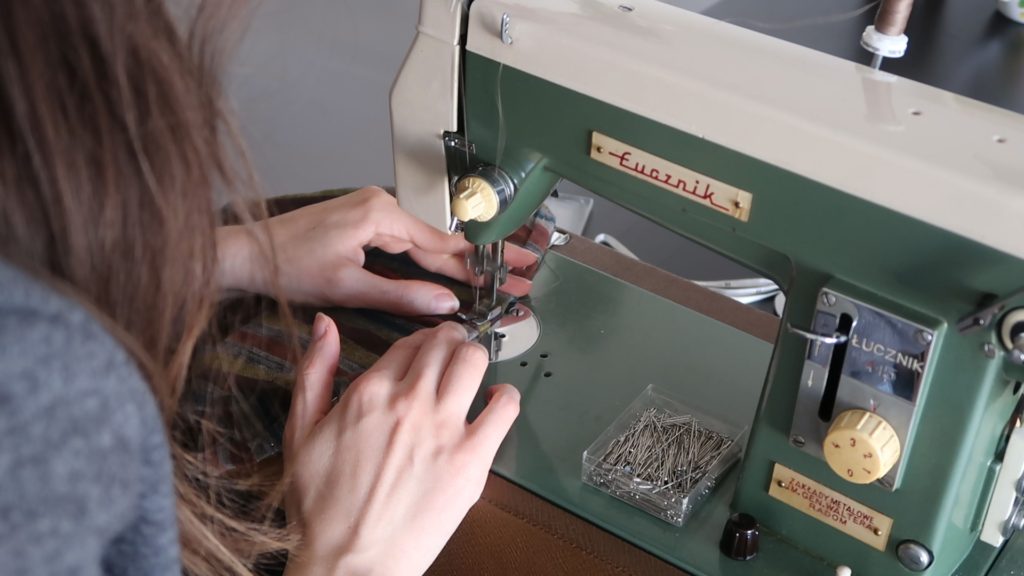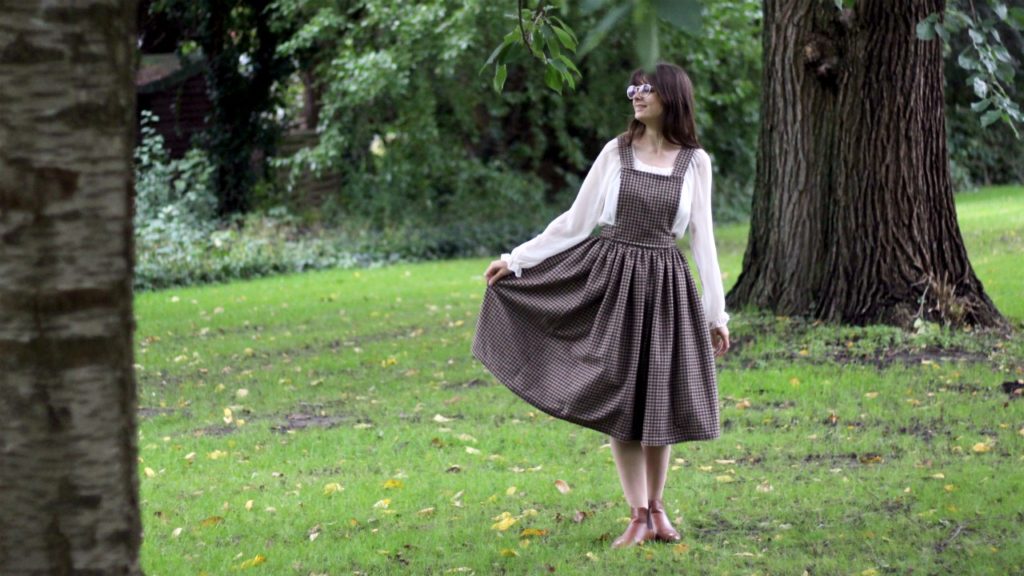Last autumn, I decided on a whim to pull out my grandma’s vintage sewing machine again and make myself something wearable for the first time in a decade. Back in highschool I went through a brief period where I made some of my clothes myself, and I loved it. It was very experimental, and everything I made was improvised and mostly hand-sewn, as I had trouble getting the sewing machine to work. Most of the items were visibly hand-made (not in a good way) and not very durable. After that period, I’d occasionally sew something simple to complete a costume or fix a clothing item, but I hadn’t taken on any bigger projects for years.
This time I wanted to go about it properly. I downloaded an English manual for my vintage Polish machine, and learned about everything it needs and has to offer. I had a collaboration with Skillshare going on at the time, so I was able to use their courses to learn some basic sewing techniques. I got some inexpensive fabric at the market here in Amsterdam, and followed a basic skirt making tutorial. I then added a chest piece and straps to make the skirt into a pinafore dress, and my first proper, wearable clothing item was born.
I enjoyed making that pinafore so much that I couldn’t wait to start a new project, and I’ve sewn something new every couple of weeks ever since. Most of my projects are documented in videos as I really enjoy taking my viewers along as I learn a new skill. I’ve been told, to my great joy, that those videos, with all the sewing mistakes and fixes left in, are quite encouraging for other beginning seamstresses or people who’d like to start sewing too. In this post I’d like to share some of my top tips for when you’re just starting out with sewing, to make sure the process is as succesful and enjoyable as possible.
Start With Quick Reward Projects
One of the most important things when starting any new hobby, is to build excitement and find joy in doing it. For me, as a result-driven person, beginner’s joy comes most easily through simple, quick projects that are likely to work out well on the first try. Keeping disappointments and hardships to a minimum at the very start is key for me to actually stick with a new skill. If you’re like me, I suggest making your first project a nice and simple “quick reward” one, and then build up sewing confidence from there.
People often recommend you start out with sewing something like a pillow case or hair accessory, but I recommend finding a project that truly excites you and that you’d actually like to use once it’s finished. A circle skirt or half-circle skirt with a simple waist band and hook-and-eye closure is one of the simplest clothing items to make, and will come out wearable in just a few steps.

Choose The Right Fabric
When it comes to fabrics, I still have a lot to learn myself. However, I do know there are easy and much harder fabrics to work with. For your first few projects, try sticking to fabrics that are:
- Easy to work with. Go for light to medium weight woven fabrics in cotton, linen, or a blend containing either of the two. These won’t stretch, fray as easily, or be too slippery, which makes them easier to handle.
- Inexpensive. You will make mistakes as a beginner and you might have to cut some pieces out more than once because of it, so start with budget friendly fabrics that won’t break the bank.
- Simple. If you go for a patterned fabric, make sure it’s a pattern that you don’t need to line up in order for it to look good. Smaller, isolated or “random” patterns such as small florals or polka dots are generally easier than large scene depictions or stripes and plaid, which need to be matched up on your garment.
Alter Or Use Existing Clothes
If sewing a clothing item from scratch is a bit intimidating, try altering something you already have in your closet or something you buy at the thrift store. I alter nearly everything I get second hand, to make sure the waist fits well and the hem is the right length.
Altering clothes will help you get a better understanding of how clothing is constructed, how the seams run, and what happens when you remove or add a bit of fabric in certain places.
Dive Into The Sewing World
When you uncover a world that was previously unknown to you, you’ll come across a wealth of new and exciting information. It might feel overwhelming, but you don’t have to soak up all the tips, techniques and best practices all at once. I suggest finding a couple sewing sources that speak to you, and starting from there.
My preferred sources are blogs, for the detailed and searchabel info, and YouTubers/Instagrammers, for the visuals and inspiration. You could of course read a sewing book instead, follow and online or real-life course, start a sewing board on Pinterest… Or all of the above. Whatever you do, try to surround yourself with sewing, but don’t pressure yourself to understand everything right away. Do it for fun. You’ll end up soaking up more info and jargon that you’d think, and get a much better understanding of the sewing world.
Ask For Help
Learning a new skill is fun, but also comes with a bunch of challenges. The good news is, you don’t have to overcome these all by yourself! Sewing is an ancient art that has been around for thousands of years, and every problem you come across has been solved countless times already. Don’t be afraid to ask for help! The easiest way to get help is, of course, from a more experienced sewist in your social circle. If you can find someone willing to teach and mentor you, that’ll be a great help.
If you don’t have access to someone like that, you can always turn to the internet. Googling a question you have can often yield great results, but you could also ask your question on a forum or on social media.

Practice With Existing Designs
For me personally, and I’m sure for many others, a large part of the appeal of learning how to sew is gaining the ability to create custom designs. Jumping straight into this from the get go complicates things a lot, though. Sewing and designing are two separate fields, and you may want to start by learning how to sew first to save yourself a lot of frustration over incorrectly drafted patterns and not-so-great designs on top of all the technical skills you’re still learning.
There are lots of fantastic designs and even ready-to-go patterns out there already that you can choose from for your first couple projects. Once you know the basics of garment construction, I highly encourage you to try making some original designs; but don’t feel like you have to invent something completely unique every time to you sit down to sew.
Experiment
Most of all, I’d like to encourage you to experiment. Try new techniques, try different ways to achieve certain results, different fabrics, patterns… If there’s anything you want to make, try it. Be prepared to fail along the way, and try anyway. The best way to learn any new skill is by simply doing it over and over again. Document your progress, take notes of your process. And most importantly: have fun!






That was so nice to read! I’m also on a beginner journey to learning to sew. I started about a year ago and this quarantined time was really useful to go deeper into it. If I could add something to the list is to learn how to hand sew first and have PATIENCE, the machine can be intimidating and create problems of it’s own (jamming, wrinkling, stabbed fingernails, broken needles) so I started off with hand sewing just to get the idea how fabric works. I still do a lot of things by hand, but I don’t feel as intimidated by the machine anymore and it really helps with more complicated projects. By the way, I got my machine as a present and its a very fancy singer one (thanks mom!). Having a very complete machine is really motivating to do all sorts of projects, so I do recommend the investment.
Hi, 5 years ago my life completely changed when I was diagnosed with MS. I had to leave my physical job and became very depressed. 3 years ago my husband bought me a sewing machine, and in its box it stayed….until 6 months ago.
I’m now 50 and learning new crafts, mainly sewing, knitting and crochet. I’ve even set up a Folksy shop (but I have no confidence in promoting it!). Nonetheless, sewing and yarn craft has lifted my mood, taken the focus away from my pain and made me feel useful again!
If you know anyone who is disabled (or able for that matter!) and has expressed a desire to learn a hobby but they lack confidence (please give them a little good will push :)
It’s so funny that you posted this, as I was just looking for information on how to begin sewing. Funny how the universe works! :)
My grandma passed away in December and I’ve had an old sewing machine of hers since I was about 10, but haven’t used it since I was 15 (14 years ago!) I’ve thought about getting it out, but have hesitated since she’s not around to remind me how to thread it, as it too is an old baby! This post was encouraging to me, and was probably what I needed to nudge me in the direction of dusting off the vintage Singer and putting her to use; thank you.
Thank you for sharing this! I started following you on YouTube after I got a sewing machine for Christmas. My long term goal is to have a mostly me made/altered wardrobe in a few years. It really helps when I get frustrated to know I’m not only in stumbling through learning.
Best of luck in your journey! :)